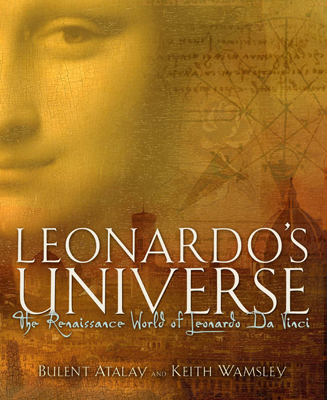LEONARDO'S UNIVERSE
The Renaissance World of Leonardo da Vinci
by
Bulent Atalay and Keith Wamsley
![]() NATIONAL GEOGRAPHIC BOOKS
NATIONAL GEOGRAPHIC BOOKS
Offering a new look at the astonishing genius of Leonardo da Vinci, a celebrity in the book world more than five centuries after his birth, Leonardo's Universe: The Renaissance World of Leonardo da Vinci (National Geographic Books, January 2009, ISBN: 978-1-4262-0285-8) reveals the man in full. This multi-dimensional portrait is unique in connecting Leonardo’s brilliance in mathematics and the sciences with his extraordinary artistic talents.
Co-authors Bulent Atalay, a scientist and artist who wrote Math and the Mona Lisa: The Art and Science of Leonardo da Vinci (now in 12 languages), and Keith Wamsley, a classicist and historian, skillfully illuminate Leonardo’s legacy in all its many facets. They portray him as a poignantly tragic character, who, more than any other, invented the future, but did not influence it. We stand in awe of his accomplishments and at the same time feel the intense frustration that he did not complete more of his commissions. So many of the devices that he invented and so many of the natural laws that he discovered would not come to light until centuries later, after they were developed independently or rediscovered anew.
Among the many astounding revelations in Leonardo's Universe:
-
Leonardo produced only a dozen paintings in his entire life, yet two of them are among the most famous works in the history of art.
-
Not only was Leonardo left-handed, he wrote backwards in “mirror text” (most likely to avoid smearing the ink and snagging the point of his quill in the paper).
-
Leonardo frequently used his fingers to mix colors on the surface of his paintings. His fingerprints are now on file with the FBI.
-
Leonardo’s surpassing prescience is evident in his sketch-filled notebooks. He invented entire fields of science hundreds of years before they were reinvented by future scientists: geology, physics, aeronautics, hydrodynamics, meteorology, physiology…
-
A century before Galileo, Leonardo recognized the parabolic trajectories of projectiles and the constant acceleration of falling bodies.
-
160 years before Newton invented the reflecting telescope (circa 1668), Leonardo designed it.
-
Leonardo designed a tank, submarine, pontoon shoes, dredger, odometer, anemometer, hygrometer, and perhaps even a bicycle.
-
With visions of human flight, he designed strap-on ornithopter wings, an aerial screw (foreshadowing the helicopter), and a parachute — 400 years before heavier-than-air human flight became a reality.
-
Leonardo invented robotics a full five centuries before our age, when this technology has become an integral part of modern manufacturing.
-
Prefiguring Darwin by 350 years, Leonardo made a statement recognizing the necessity of organisms to evolve in order to survive.
-
He described hardening of the arteries (atherosclerosis) four hundred years before physicians at the University of Vienna Medical School identified the disease.
-
Leonardo appears to have understood circulation of blood more than a century before William Harvey’s discovery of the phenomenon.
-
Leonardo’s anatomical drawings are the best ever produced. Cardiac surgeon Francis Wells in Cambridge (UK) introduced a new technique in mitral valve repair inspired by Leonardo’s drawings of the human heart and his general methodology, and has successfully applied the technique on over 250 patients.
Magnificently illustrated and richly visual, Leonardo's Universe deftly explores the master’s insights and brilliance through his own art and writings against the spellbinding backdrop of the Renaissance world.
Order your copy:
